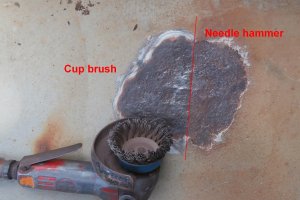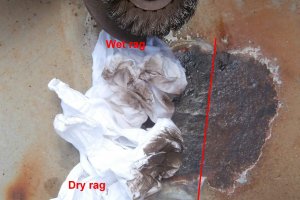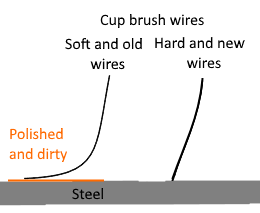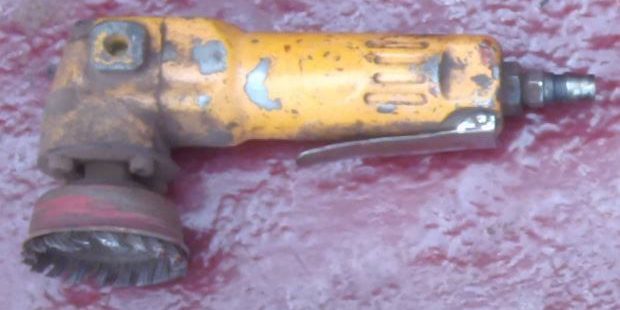In this post I will devote a little time to an often used tool for surface preparation, the rotating wire brush.
Wire brushing is used and misunderstood, as an easy and cheap method to “clean” corroded spots before painting.
Its use, combines a couple of the common mistakes we do in surface preparation, and is part of the reason the coating so often fails after a short time.
It is the single worst method of surface preparation and it should never be used onboard.
I will try to explain why it is so in-efficient and what to do instead.
To achieve a good surface preparation and a long lasting coating repair we need:
A Clean Surface with a Rough profile and Sufficient paint.
What surface quality will the rotating wire brush give us?
If you are using the rotating wire brush onboard, I will challenge you to make a spot of corrosion “ready for painting” to your normal standards and test the cleanliness.

You will need:
• a rotating wire brush
• a bucket of water
• a clean hand steel brush
• a clean white rag
- Clean the area to the usual standard before painting
- Scrub the spot with a clean hand steel brush with a little water.
- Clean it off with a white rag.

The rotating wire brush will leave a DIRTY – SMOOTH surface where the paint will fall off after a short time.
Do you see the problem?

What happens is that the wires after a short time, will go soft and bend by the rotational force. Causing it to polish the surface without removing the corrosion.
Often the same cup brush is used for cleaning grease of turnbuckles in the morning and spot corrosion in the afternoon.
That does not improve the quality of the work.
To avoid the rotating wirebrushes is used for surface preparations by mistake:
I will suggest that all rotating wire brushes onboard are collected and landed at the next garbage facility.
Should rotating wire brushes never be used?
The short answer is NO. Never, ever. It simply makes a poor job.
A variety of tools exist that will do a much better job. They may cost a little more in purchase and may not be as easy.
On the other hand it is neither Efficient, Practical, Easy or cheap to re-do the work every 6-12 months.
But not rules without exceptions:
It can be difficult to get all the dirt and corrosion out of small pittings and un-even weldings, if blasting (sand or water) or a straight grinder is not available.
In this case a new stiff rotating wirebrush can be used to clean the in-accesible areas.
Use a hand wire brush with fresh water afterwards to clean of the dirt.
You will then have a:
Smooth Clean surface with hopefully enough paint on.
It is not a very practical or easy method but at least it is better than leaving it dirty.
Roughening it a little with sand paper or an abrasive disc will make the surface a little better.
What to do instead
This is an easy one to answer – any other method of surface preparation is better.
Abrasive discs, sanding, sand blasting, water blasting will always be the better choice.
The posts: Painting schedule and Hydro Blasting includes ways to clean the surface to a good standard using power tools and sand blasting.
Use a method that will leave the surface Clean, Rough and ready for painting.
Safe sailing
Feel free to use the content to explain why not to use the rotating wire brush to the onboard crew.
If you have any comments or questions to this blog post or corrosion maintenance onboard in general feel free to comment below or send me a message.







